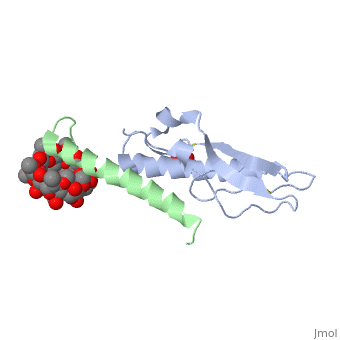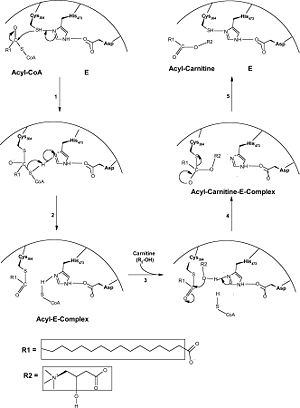Glucose-dependent Insulinotropic Polypeptide Receptor
From Proteopedia
(Difference between revisions)
| Line 1: | Line 1: | ||
| - | < | + | <StructureSection load='2qkh' size='350' side='right' caption=Glucose-dependant insulinotropic polypeptide receptor (grey) complex with hormone GIP (green), methyl-cyclo-hepta-amylose and tartaric acid , [[2qkh]]' scene=''> |
[[Image:F3.large.jpg|thumb|300px|left|GIP-induced Pathway.<ref>PMID:12475913</ref>]] | [[Image:F3.large.jpg|thumb|300px|left|GIP-induced Pathway.<ref>PMID:12475913</ref>]] | ||
| Line 47: | Line 47: | ||
===Ongoing Research=== | ===Ongoing Research=== | ||
The significance of this receptor makes it a prime target for [[Diabetes]] research. Incretins are a class of biological molecules that act like gastrointestinal hormones. One such example is glucagon-like peptide-1 (GLP-1), which works with GIP to regulate the body's insulin levels. Synthetic versions of this peptide hormone have been made to treat people with type-2 diabetes. It works by stimulating GIP production as well as insulin secretion causing the body to properly regulate its blood glucose levels like someone without diabetes. The benefit of synthetic GLP-1 is that it is not protein and so would not be degraded as easily therefore prolonging the benefits of the drug. One such example is Byetta<ref>"Byetta." BYETTA (exenatide) Injection | Welcome to BYETTA.com. Amylin Pharmaceuticals, Inc., 2011. Web. 02 Dec. 2011. <http://www.byetta.com/Pages/index.aspx></ref>. | The significance of this receptor makes it a prime target for [[Diabetes]] research. Incretins are a class of biological molecules that act like gastrointestinal hormones. One such example is glucagon-like peptide-1 (GLP-1), which works with GIP to regulate the body's insulin levels. Synthetic versions of this peptide hormone have been made to treat people with type-2 diabetes. It works by stimulating GIP production as well as insulin secretion causing the body to properly regulate its blood glucose levels like someone without diabetes. The benefit of synthetic GLP-1 is that it is not protein and so would not be degraded as easily therefore prolonging the benefits of the drug. One such example is Byetta<ref>"Byetta." BYETTA (exenatide) Injection | Welcome to BYETTA.com. Amylin Pharmaceuticals, Inc., 2011. Web. 02 Dec. 2011. <http://www.byetta.com/Pages/index.aspx></ref>. | ||
| - | + | </StructureSection> | |
===3D structures of GIPR=== | ===3D structures of GIPR=== | ||
Revision as of 13:14, 1 April 2019
| |||||||||||
3D structures of GIPR
Updated on 01-April-2019
2qkh - GIPR + GIP - human
References
- ↑ Lynn FC, Thompson SA, Pospisilik JA, Ehses JA, Hinke SA, Pamir N, McIntosh CH, Pederson RA. A novel pathway for regulation of glucose-dependent insulinotropic polypeptide (GIP) receptor expression in beta cells. FASEB J. 2003 Jan;17(1):91-3. Epub 2002 Nov 15. PMID:12475913 doi:10.1096/fj.02-0243fje
- ↑ Lynn FC, Pamir N, Ng EH, McIntosh CH, Kieffer TJ, Pederson RA. Defective glucose-dependent insulinotropic polypeptide receptor expression in diabetic fatty Zucker rats. Diabetes. 2001 May;50(5):1004-11. PMID:11334402
- ↑ "Byetta." BYETTA (exenatide) Injection | Welcome to BYETTA.com. Amylin Pharmaceuticals, Inc., 2011. Web. 02 Dec. 2011. <http://www.byetta.com/Pages/index.aspx>
See Also
Proteopedia Page Contributors and Editors (what is this?)
Michal Harel, David Canner, Alexander Berchansky, Logan Brushart, Wayne Decatur


